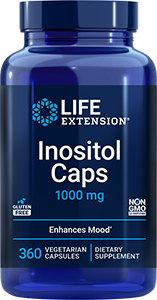- Science & Research
- Science News
- Newsletter
- 2007
- November 6

Newsletter
Newsletter
Inositol protects DNA from radiation
 | |||||||||||||||||||||||||||||||||||
| |||||||||||||||||||||||||||||||||||
| |||||||||||||||||||||||||||||||||||
| Life Extension Update Exclusive Inositol protects DNA from radiation Research reported on November 5, 2007 at the American Association for Cancer Research Centennial Conference on Translational Cancer Medicine indicates that inositol as well as inositol hexaphosphate (IP6) helps protect the body’s genetic material from the damaging effects of ultraviolet B (UVB) and other radiation. University of Maryland School of Medicine professor of pathology Abulkalam M. Shamsuddin, MD reported that these antioxidant nutrients protect the cells’ DNA from radiation-generated free radicals. In addition to providing protection from UVB, inositol could be used to help decrease the side effects of cancer radiation therapy by increasing the treatment’s potency against malignant cells while protecting those that are healthy. In one experiment, Dr Shamsuddin’s team treated human skin cells known as keratinocytes with IP6 while leaving others untreated before irradiating them with UVB. Treated cells were less likely to undergo genetically programmed self-destruction (apoptosis), indicating that they had less irreparable DNA damage. Dr Shamsuddin explained that the cells treated with IP6 take an extended pause at the point in their life cycle where DNA is repaired before cell division. “IP6 certainly has some interactivity with DNA, but how exactly it works to repair DNA is still something of a mystery,” he said. “There are reports that IP6 binds with DNA repair molecule Ku to bring about the repair process. More importantly, we still don’t know how IP6 can appear to help healthy cells live while also enhancing the ability of radiation to kill cancer cells.” In another experiment, the researchers gave drinking water containing two percent IP6 to part of a group of mice genetically engineered to have an increased risk of developing skin cancer. Tumors developed in 23 percent of these mice compared with 51 percent of those who did not receive IP6, and the number of tumors in the mice that received IP6 was half that of the untreated animals. In yet another experiment, a cream containing inositol and IP6 helped to protect against the development of tumors in mice exposed to UVB radiation equivalent to sun exposure. “Both of these potent antioxidants have been shown to have broad-spectrum antitumor capabilities, and now our studies confirm the degree to which these molecules protect against the DNA-damaging effects of ionizing radiation,” Dr Shamsuddin stated. “Radiation damage is radiation damage, regardless of the source, so there could also be a protective role for IP6 in any form of radiation exposure, whether it is from a therapeutic dose or from solar, cosmic or nuclear sources.” “It is possible that people regularly exposed to ionizing radiation, such as airline pilots, frequent fliers or people who handle radioactive materials, might take IP6 prophylactically to prevent possible long term effects of exposure,” he added. “It could also be advisable to use IP6 plus inositol as a cautionary treatment following a nuclear disaster or dirty bomb.” Although there are many diseases that can affect the skin, the most common problems that we all have are the effects of our exposure to ultraviolet (UV) radiation from the sun over time. In the last 10 years, with the changes in the ozone layer in the upper atmosphere, it is clear that the effects of UV radiation from the sun are much more dangerous than originally thought. There are many causes for the accumulated cellular damage in the skin that we call aging. Among these are the oxidative processes and related free radical damage that result from UV sunlight, smog, toxins, cigarette smoke, X-rays, drugs, and other stressors. Young skin is also exposed to these potentially damaging changes, but when we are young, there is sufficient cellular energy (ATP) for DNA repair and cell renewal. Enzymes that provide antioxidant activity such as SOD and catalase are readily available. As we age, there is increased wear and tear, while at the same time the energy for cell repair and renewal is diminished and the antioxidant enzymes are less available. Human studies have demonstrated pronounced protective effects of antioxidants when applied topically before UV radiation exposure. With respect to UVB-induced skin damage, the photoprotective effects of antioxidants are significant. Topical application of such combinations may result in a sustained antioxidant capacity of the skin, possibly due to antioxidant synergisms. Free radicals are culprits behind UVA-induced skin alterations, thus indicating a basis for topical antioxidant administration. In a human study, topical application of antioxidants resulted in diminished severity of UVA-induced sun damage. Thus, regular application of skin care products containing antioxidants may be of the utmost benefit in efficiently preparing skin against exogenous oxidative stressors occurring during daily life. Sunscreen agents may also benefit from combination with antioxidants resulting in increased safety and efficacy of such photoprotective products (Dreher et al. 2001). Featured Products
| |||||||||||||||||||||||||||||||||||
| If you have questions or comments concerning this issue or past issues of Life Extension Update, send them to ddye@lifeextension.com or call 1-800-678-8989. For longer life,  Dayna Dye
Sign up for Life Extension Update at News Subscription Help spread the good news about living longer and healthier. Forward this email to a friend! View previous issues of Life Extension Update in the Newsletter Archive. | |||||||||||||||||||||||||||||||||||
The latest news on aging, nutrition, and vitamins
Lab
Testing
How Life Extension lab testing works


